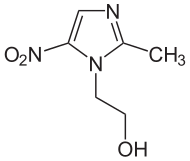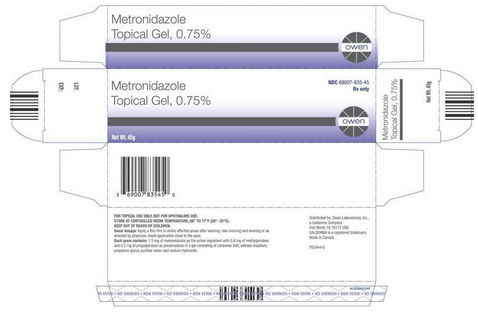Metronidazole (topical)
Editor-In-Chief: C. Michael Gibson, M.S., M.D. [1]; Associate Editor(s)-in-Chief: Adeel Jamil, M.D. [2]
Disclaimer
WikiDoc MAKES NO GUARANTEE OF VALIDITY. WikiDoc is not a professional health care provider, nor is it a suitable replacement for a licensed healthcare provider. WikiDoc is intended to be an educational tool, not a tool for any form of healthcare delivery. The educational content on WikiDoc drug pages is based upon the FDA package insert, National Library of Medicine content and practice guidelines / consensus statements. WikiDoc does not promote the administration of any medication or device that is not consistent with its labeling. Please read our full disclaimer here.
Overview
Metronidazole (topical) is a anti-infective agent, antiparasitic and antiprotozoal agent that is FDA approved for the treatment of inflammatory papules and pustules of rosacea. Common adverse reactions include burning, skin irritation, dryness, transient redness, metallic taste, tingling or numbness of extremities and nausea..
Adult Indications and Dosage
FDA-Labeled Indications and Dosage (Adult)
- Metronidazole topical gel is indicated for topical application in the treatment of inflammatory papules and pustules of rosacea.
Dosing Information
- Apply and rub in a thin film of metronidazole topical gel twice daily, morning and evening, to entire affected areas after washing.
- Areas to be treated should be cleansed before application of metronidazole topical gel. Patients may use cosmetics after application of metronidazole topical gel.
Off-Label Use and Dosage (Adult)
Guideline-Supported Use
There is limited information regarding Off-Label Guideline-Supported Use of Metronidazole (gel) in adult patients.
Non–Guideline-Supported Use
There is limited information regarding Off-Label Non–Guideline-Supported Use of Metronidazole (gel) in adult patients.
Pediatric Indications and Dosage
FDA-Labeled Indications and Dosage (Pediatric)
There is limited information regarding Metronidazole (topical) FDA-Labeled Indications and Dosage (Pediatric) in the drug label.
Off-Label Use and Dosage (Pediatric)
Guideline-Supported Use
There is limited information regarding Off-Label Guideline-Supported Use of Metronidazole (gel) in pediatric patients.
Non–Guideline-Supported Use
There is limited information regarding Off-Label Non–Guideline-Supported Use of Metronidazole (gel) in pediatric patients.
Contraindications
- Metronidazole topical gel is contraindicated in individuals with a history of hypersensitivity to metronidazole, parabens, or other ingredients of the formulation.
Warnings
PRECAUTIONS:
General:
- Metronidazole topical gel has been reported to cause tearing of the eyes. Therefore, contact with the eyes should be avoided. If a reaction suggesting local irritation occurs, patients should be directed to use the medication less frequently or discontinue use. Metronidazole is a nitroimidazole and should be used with care in patients with evidence of, or history of blood dyscrasia.
Adverse Reactions
Clinical Trials Experience
- The following adverse experiences have been reported with the topical use of metronidazole: burning, skin irritation, dryness, transient redness, metallic taste, tingling or numbness of extremities and nausea.
Postmarketing Experience
There is limited information regarding Metronidazole (topical) Postmarketing Experience in the drug label.
Drug Interactions
- Oral metronidazole has been reported to potentiate the anticoagulant effect of coumarin and warfarin resulting in a prolongation of prothrombin time. The effect of topical metronidazole on prothrombin time is not known.
Use in Specific Populations
Pregnancy
- There has been no experience to date with the use of metronidazole topical gel in pregnant patients. Metronidazole crosses the placental barrier and enters the fetal circulation rapidly. No fetotoxicity was observed after oral metronidazole in rats or mice. However, because animal reproduction studies are not always predictive of human response and since oral metronidazole has been shown to be a carcinogen in some rodents, this drug should be used during pregnancy only if clearly needed.
Pregnancy Category (AUS):
There is no Australian Drug Evaluation Committee (ADEC) guidance on usage of Metronidazole (topical) in women who are pregnant.
Labor and Delivery
There is no FDA guidance on use of Metronidazole (topical) during labor and delivery.
Nursing Mothers
- After oral administration, metronidazole is secreted in breast milk in concentrations similar to those found in the plasma. Even though metronidazole topical gel blood levels are significantly lower than those achieved after oral metronidazole, a decision should be made whether to discontinue nursing or to discontinue the drug, taking into account the importance of the drug to the mother.
Pediatric Use
There is no FDA guidance on the use of Metronidazole (topical) in pediatric settings.
Geriatic Use
There is no FDA guidance on the use of Metronidazole (topical) in geriatric settings.
Gender
There is no FDA guidance on the use of Metronidazole (topical) with respect to specific gender populations.
Race
There is no FDA guidance on the use of Metronidazole (topical) with respect to specific racial populations.
Renal Impairment
There is no FDA guidance on the use of Metronidazole (topical) in patients with renal impairment.
Hepatic Impairment
There is no FDA guidance on the use of Metronidazole (topical) in patients with hepatic impairment.
Females of Reproductive Potential and Males
There is no FDA guidance on the use of Metronidazole (topical) in women of reproductive potentials and males.
Immunocompromised Patients
There is no FDA guidance one the use of Metronidazole (topical) in patients who are immunocompromised.
Administration and Monitoring
Administration
- Topical
Monitoring
There is limited information regarding Metronidazole (topical) Monitoring in the drug label.
IV Compatibility
There is limited information regarding the compatibility of Metronidazole (topical) and IV administrations.
Overdosage
There is limited information regarding Metronidazole (topical) overdosage. If you suspect drug poisoning or overdose, please contact the National Poison Help hotline (1-800-222-1222) immediately.
Pharmacology
Mechanism of Action
There is limited information regarding Metronidazole (topical) Mechanism of Action in the drug label.
Structure
- Metronidazole topical gel contains metronidazole, USP, at a concentration of 7.5 mg per gram (0.75%) in a gel consisting of carbomer 940, edetate disodium, methylparaben, propylene glycol, propylparaben, purified water, and sodium hydroxide. Metronidazole is classified therapeutically as an antiprotozoal and antibacterial agent. Chemically, metronidazole is named 2-methyl-5-nitro-1H-imidazole-1-ethanol and has the following structure:

Pharmacodynamics
- Bioavailability studies on the topical administration of 1 gram of metronidazole topical gel (7.5 mg of metronidazole) to the face of 10 rosacea patients showed a maximum serum concentration of 66 nanograms per milliliter in one patient. This concentration is approximately 100 times less than concentrations afforded by a single 250 mg oral tablet. The serum metronidazole concentrations were below the detectable limits of the assay at the majority of time points in all patients. Three of the patients had no detectable serum concentrations of metronidazole at any time point. The mean dose of gel applied during clinical studies was 600 mg which represents 4.5 mg of metronidazole per application. Therefore, under normal usage levels, the formulation affords minimal serum concentrations of metronidazole. The mechanisms by which metronidazole topical gel acts in the treatment of rosacea are unknown, but appear to include an anti-inflammatory effect.
Pharmacokinetics
There is limited information regarding Metronidazole (topical) Pharmacokinetics in the drug label.
Nonclinical Toxicology
Carcinogenesis, mutagenesis, impairment of fertility:
- Metronidazole has shown evidence of carcinogenic activity in a number of studies involving chronic, oral administration in mice and rats but not in studies involving hamsters.
- Metronidazole has shown evidence of mutagenic activity in several in vitro bacterial assay systems. In addition, a dose-response increase in the frequency of micronuclei was observed in mice after intraperitoneal injections and an increase in chromosome aberrations have been reported in patients with Crohn’s disease who were treated with 200-1200 mg/day of metronidazole for 1 to 24 months. However, no excess chromosomal aberrations in circulating human lymphocytes have been observed in patients treated for 8 months.
Clinical Studies
There is limited information regarding Metronidazole (topical) Clinical Studies in the drug label.
How Supplied
Metronidazole topical gel is supplied in a 45 g aluminum tube – NDC 69007-835-45.
Distributed by: Owen Laboratories, Inc., a Galderma Company Galderma is a registered trademark. Made in Canada
P52445-0 Revised: June 2014
Storage
- STORE AT CONTROLLED ROOM TEMPERATURE: 68° to 77°F (20° to 25°C).
Images
Drug Images
{{#ask: Page Name::Metronidazole (topical) |?Pill Name |?Drug Name |?Pill Ingred |?Pill Imprint |?Pill Dosage |?Pill Color |?Pill Shape |?Pill Size (mm) |?Pill Scoring |?NDC |?Drug Author |format=template |template=DrugPageImages |mainlabel=- |sort=Pill Name }}
Package and Label Display Panel

LOT:
EXP.:
Metronidazole Topical Gel 0.75%
NDC 69007-835-45
Rx only
NET WT. 45 g
Owen
FOR TOPICAL USE ONLY. NOT FOR OPTHALMIC USE.
STORE AT CONTROLLED ROOM TEMPERATURE, 68° to 77°F (20° - 25°C).
KEEP OUT OF REACH OF CHILDREN.
Ususal dosage: Apply a thin film to the entire affected areas after washing. Use morning and evening or as directed by physician. Avoid application close to the eyes.
Each gram contains: 7.5 mg of metronidazole as active ingredient with 0.8 mg of methylparaben and 0.2 mg of propylparaben as preservatives in a gel consisting of carbomer 940, edetate disodium, propylene glycol, purified water, and sodium hydroxide.
Distributed by: Owen Laboratories, Inc.
a Galderma Company
Fort Worth, TX 76177 USA
Made in Canada.
P52444-0 {{#ask: Label Page::Metronidazole (topical) |?Label Name |format=template |template=DrugLabelImages |mainlabel=- |sort=Label Page }}
Patient Counseling Information
- This medication is to be used as directed by the physician. It is for external use only. Avoid contact with the eyes.
Precautions with Alcohol
Alcohol-Metronidazole (gel) interaction has not been established. Talk to your doctor about the effects of taking alcohol with this medication.
Brand Names
There is limited information regarding Metronidazole (topical) Brand Names in the drug label.
Look-Alike Drug Names
There is limited information regarding Metronidazole (topical) Look-Alike Drug Names in the drug label.
Drug Shortage Status
Price
References
The contents of this FDA label are provided by the National Library of Medicine.
- ↑ 1.0 1.1 1.2 1.3 1.4 "Flagyl, Flagyl ER (metronidazole) dosing, indications, interactions, adverse effects, and more". Medscape Reference. WebMD. Retrieved 3 April 2014.
- ↑ 2.0 2.1 2.2 2.3 2.4 Brayfield, A, ed. (14 January 2014). "Metronidazole". Martindale: The Complete Drug Reference. Pharmaceutical Press. Retrieved 3 April 2014.

